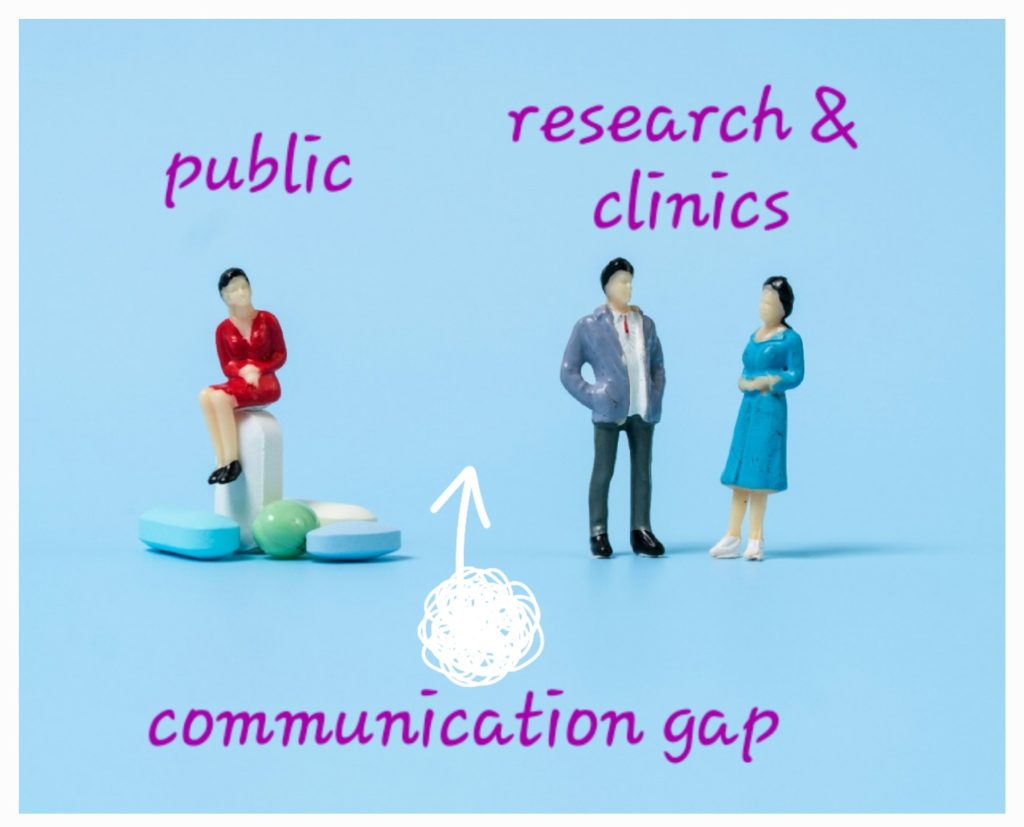
Translating Translational Research
This April, I defended my PhD thesis at the University of Tartu and Karolinska Institutet. It was a very interesting experience to work across two countries and institutions, and to interact with people from different fields and backgrounds. My research focused on endometriosis, a complex gynaecological condition that affects the lives of many women of reproductive age (around 10% of women worldwide). Because the origin and development of endometriosis are still unclear, the diagnosis often takes far too long, sometimes up to 10 years. The current treatments for endometriosis are non-specific and mostly symptomatic. Therefore, new approaches and more powerful techniques are required to investigate this complex disease, which also brings new challenges with collecting and analysing large datasets, and then making knowledge useful for others.
During my PhD, I met a few researchers from other fields who are personally affected by endometriosis, and I learned that for them it was difficult to understand research articles on this topic and follow the progress in the field. This showed me that most advances are visible and understandable mainly to specialists working on this disease. In other words, translation is needed not only into clinical practice but also into everyday understanding. That is why in this post, I would like to talk about translational research in general, its challenges, and what we could try to do about the gaps.
From Lab to Life: The Need for Public Translation
Translational research is about moving discoveries from the lab to the clinic, translating findings into clinical practice. Yet, there is another kind of translation, quite often missed, – bringing new knowledge to the lay public, keeping the public up-to-date in a way that ensures a thoughtful and ‘user-friendly’ language, but not (over)simplified.

Basic information on diseases is available on both high-quality websites and some sources that may actually be misleading for the lay public. Currently, researchers try to spread their findings and achievements through social media, but in most cases this information is ‘digestible’ only for their colleagues from the field. When posts are written at a superficial level, they can sometimes leave readers confused about whether there has been a scientific breakthrough that will end the battle with the disease, or even whether the field is progressing at all. The scientific progress is not always evident from oversimplified overviews, which create the impression of repetitive information. And here we understand that careful and considered language is essential and has to be developed for all parties.
To communicate better, probably we need to provide:
• Basic disease knowledge (including the aims of translational research and modern methods)
• Clear, well-categorised research directions
• Updates on advances, written accessibly and clearly, without overloading readers
This is an important point, as public awareness of diseases and progress in translational research improves understanding of “why public funds go to translational research”, especially for understudied diseases (for example, only 0.038% of NIH’s total funding in US went to endometriosis in 2022*, and only 0.019% of all EU-funded projects targeted endometriosis**), “what we aim to change and achieve in research”, and maybe even “what we might do to live healthier and longer lives”.
What Could Move the Needle
Can artificial intelligence (AI) potentially help us build a system to develop research/ clinic to public communication? Probably, yes – it could help to analyse large datasets, interpret the results and create user-friendly materials for people. But of course, several points should be considered (and developed): high-quality input data, the system has to be trained and then curated by researchers and clinicians (paid for their time and effort, with a possibility of creating new jobs) followed by a manual check of the output information. To see how it currently works and without specific training, I ran a test on ChatGPT (GPT-5). I asked it to summarise each of my three publications, as well as a short summary of my thesis (300 words) taking into account that it is intended for a lay audience. It summarised the articles quite well, keeping key messages accurate and readable. Thus, we can assume that we already have a good starting tool to make scientific knowledge accessible for the wider community.
Help from science-communication specialists is also essential; their skills help build connections between researchers/clinicians and the public. Public engagement initiatives, for example, are at an early stage in Sweden (European Commission’s Mutual Learning Exercise focusing on Public Engagement in Research & Innovation) and hopefully we will come to a point where each party can engage effectively.
Hopefully, we will develop a better system connecting research – clinics – communities in ways that have real impact, leading to more responsible and high-quality research. And maybe, with the right tools and people, we can make science more open, helpful, and human-oriented.

A quick note with regard to new techniques in research. As I mentioned in the beginning, another priority for translational research is moving to more advanced techniques to decode both disease and healthy states. This allows for a more holistic approach exploring disease at cellular and molecular levels, with a potential for personalised medicine. However, these methods are rather expensive and require training researchers to analyse and interpret obtained results, which requires good and sufficient funding. Otherwise, progress becomes slow, happening only in a small circle of experts who have access to the advanced tools. This again underlines the importance of public awareness and understanding of where we currently are in research and why we need funding to make further progress.
GPT-5 generated summaries
Below, I add GPT-5 generated summaries of my PhD work and links to the original publications:
My thesis‘ summary:
“This research explores how endometriosis—a condition where tissue similar to the uterine lining grows outside the uterus—survives and spreads. By comparing these misplaced tissues (endometriotic lesions) with normal womb-lining cells, the thesis found that the lesions have a unique molecular “identity.” This special signature equips them to grow in unfamiliar places in the body. Factors like hormonal imbalances and areas with low oxygen (hypoxia) were shown to influence key processes such as how cells grow, move, and form blood vessels—essential for lesion survival. Importantly, the study sheds light on the roles of both hormones and oxygen levels in shaping these abnormal cell behaviors. When hormonal signals go awry or oxygen levels drop, cells can change how they generate energy, spread, and build their own blood supply—making those problematic lesions harder to treat. Understanding these cellular processes opens doors to developing treatments that directly target those survival mechanisms—meaning future therapies might block the disease at its roots rather than just masking symptoms.”
Study I summary:
“This study looked at endometriosis, a condition where tissue similar to the lining of the womb grows outside it, causing pain and health problems. Researchers compared the activity of cells from these abnormal growths with cells from the normal womb lining. They discovered that certain cells—especially those around blood vessels and in the tissue structure—use energy in unusual ways. Instead of choosing just one method, these cells use both “sugar-burning” (glycolysis) and “energy-powerhouse” (oxidative metabolism) processes at the same time, which may help the growths survive and spread. This new understanding of how cells fuel themselves could lead to treatments that target these energy processes directly, offering alternatives to hormone-based therapies for endometriosis in the future.”
Study II summary:
“Endometriosis is a condition where tissue similar to the womb lining grows in the wrong places, often causing pain and scarring. Scientists studied what happens to these tissues when they are in areas with little oxygen, which is common inside endometriosis growths. They found that normal womb-lining cells change the way they use energy under low oxygen, but endometriosis cells instead increase a specific protein called TGFBI. This protein seems to play a big role in helping the growths form scar tissue and new blood vessels, which lets them survive and spread. Because of this, TGFBI may become an important target for new treatments that don’t rely on hormones.”
Study III summary:
“This study explored how a protein called LXN (a natural inhibitor of certain enzymes) behaves in the womb lining during different phases of the menstrual cycle and in abnormal tissue related to endometriosis. The researchers found that in healthy womb tissue, LXN levels are lowest early in the menstrual cycle and rise later on. More importantly, tissues from endometriosis lesions (where womb‑like cells grow outside the uterus) showed much higher LXN levels compared to normal tissue. When scientists lowered LXN in cell experiments, the cells moved around less—suggesting LXN helps these cells travel and grow. Altogether, this means LXN may play a part in how endometriosis lesions form and spread, making it a potential target for future treatment research.”
*Ellis, K., Munro, D. & Clarke, J. Endometriosis Is Undervalued: A Call to Action. Front. Glob. Womens Health 3, 902371 (2022).
**Viganò, P., Casalechi, M. & Dolmans, M.-M. European Union Underinvestment in Endometriosis Research. J. Endometr. Uterine Disord. 5, 100058 (2024).
Images by Claudio Schwarz (1) and Etactics Inc (2, 3, modified) from Unsplash.

0 comments